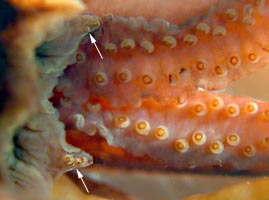Bathyteuthoidea
Richard E. Young and Michael Vecchione- Bathyteuthidae Pfeffer 1900
- Chtenopterygidae Grimpe 1922
Introduction
These are small mesopelagic to bathypelagic squids.
Brief diagnosis:
A decapodiform ...
- with suckers on the buccal membrane.
- without carpal locking-apparatus on tentacles.
- with branchial canals in gills.
Characteristics
- Arms
- Suckers in four or more series at some point on arms I-III.
- Suckers without circularis muscles.
- Tentacles
- Club not divided into manus and dactylus.
- Carpal locking-apparatus absent.
- Club suckers in more than 7 irregular series.
- Suckers without circularis muscles.
- Buccal crown
- Buccal supports bear small suckers.
- Head
- Head with tentacle pockets.
- An introduction to the beaks of the Bathyteuthoidea can be found here.
- Mantle
- Mantle locking-apparatus reaches anterior mantle edge.
- Mantle locking-apparatus reaches anterior mantle edge.
- Fins
- Fins with posterior lobes.
- Fins with posterior lobes.
- Shell
- Shell a gladius with spoon-shaped conus.
- Shell a gladius with spoon-shaped conus.
- Viscera
- Gills with branchial canals.
- Oviducts paired.
- Eggs
- Eggs in gelatinous egg masses held in arms of pelagic, brooding female (Bathyteuthidae; unknown in Chtenopterygidae).
Comments
Buccal connectives attach to the ventral borders of Arms IV in the Chtenopterygidae and to the dorsal borders in the Bathyteuthididae. Suckers on the buccal supports are found in members of only four families (Bathyteuthidae, Chtenopterygidae, Loliginidae, Sepiidae). The suckers look much like the arm suckers but are much smaller.
Discussion of Phylogenetic Relationships
The two genera that represent these families (Bathyteuthis, Cthenopteryx) were, at one time, placed within the same family (e.g., Naef, 1921) because they share a number of similar features. They especially show strong similarities in the structure of the tentacular clubs, the sucker arrangement on the arms and the morphology of their gladii. Roper (1969) considered them to belong to separate families and emphasized the differences in the attachment of the buccal crown to arms IV. Others (e.g., Clarke, 1988) have considered them to be distantly related. Their close relationship to one another, however, has been confirmed by a molecular study (Carlini, 1998).
The relationship of the Bathyteuthoidea to other groups is uncertain as they share some characters with both the Oegopsida and the Myopsida.
References
Clarke, M. R. (1988). Evolution of recent cephalopods -- A brief review. P. 331-313. In: Clarke, M. R. and E. R. Trueman (Eds.). The Mollusca. Vol. 12. Paleontology and Neontology of Cephalopods. Academic Press, New York. 355pp.
Carlini, D. B. The phylogeny of coleoid cephalopods inferred from molecular evolutionary analyses of the cytochrome oxidase I, muscle actin, and cytoplasmic actin genes. Ph.D. diss. Coll. William and Mary, 273 pp.
Naef, A. (1921/23). Cephalopoda. Fauna und Flora des Golfes von Neapel. Monograph, no. 35. English translation: A. Mercado (1972). Israel Program for Scientific Translations Ltd., Jerusalem, Israel. 863pp., IPST Cat. No. 5110/1,2.
Roper, C.F.E. 1969. Systematics and zoogeography of the worldwide bathypelagic squid Bathyteuthis (Cephalopoda: Oegopsida). Bulletin of the United States National Museum, 291:1-210.
Title Illustrations

| Scientific Name | Bathyteuthis abyssicola |
|---|---|
| Location | Antarctic waters |
| Comments | Photographed in a shipboard aquarium. |
| Copyright | © 1996 Edward McSweeny |
| Scientific Name | Chtenopteryx sp. |
|---|---|
| Location | Off Hawaii |
| Comments | The visceral and ocular photophore are visible through the transparent mantle and head muscles. |
| View | ventral |
| Image Use |
 This media file is licensed under the Creative Commons Attribution-NonCommercial License - Version 3.0. This media file is licensed under the Creative Commons Attribution-NonCommercial License - Version 3.0.
|
| Copyright |
© 1996
Richard E. Young

|
About This Page
Richard E. Young

University of Hawaii, Honolulu, HI, USA
Michael Vecchione

National Museum of Natural History, Washington, D. C. , USA
Page copyright © 2019 Richard E. Young
 Page: Tree of Life
Bathyteuthoidea .
Authored by
Richard E. Young and Michael Vecchione.
The TEXT of this page is licensed under the
Creative Commons Attribution-NonCommercial License - Version 3.0. Note that images and other media
featured on this page are each governed by their own license, and they may or may not be available
for reuse. Click on an image or a media link to access the media data window, which provides the
relevant licensing information. For the general terms and conditions of ToL material reuse and
redistribution, please see the Tree of Life Copyright
Policies.
Page: Tree of Life
Bathyteuthoidea .
Authored by
Richard E. Young and Michael Vecchione.
The TEXT of this page is licensed under the
Creative Commons Attribution-NonCommercial License - Version 3.0. Note that images and other media
featured on this page are each governed by their own license, and they may or may not be available
for reuse. Click on an image or a media link to access the media data window, which provides the
relevant licensing information. For the general terms and conditions of ToL material reuse and
redistribution, please see the Tree of Life Copyright
Policies.
- Content changed 27 February 2016
Citing this page:
Young, Richard E. and Michael Vecchione. 2016. Bathyteuthoidea . Version 27 February 2016 (under construction). http://tolweb.org/Bathyteuthoidea/19421/2016.02.27 in The Tree of Life Web Project, http://tolweb.org/









 Go to quick links
Go to quick search
Go to navigation for this section of the ToL site
Go to detailed links for the ToL site
Go to quick links
Go to quick search
Go to navigation for this section of the ToL site
Go to detailed links for the ToL site